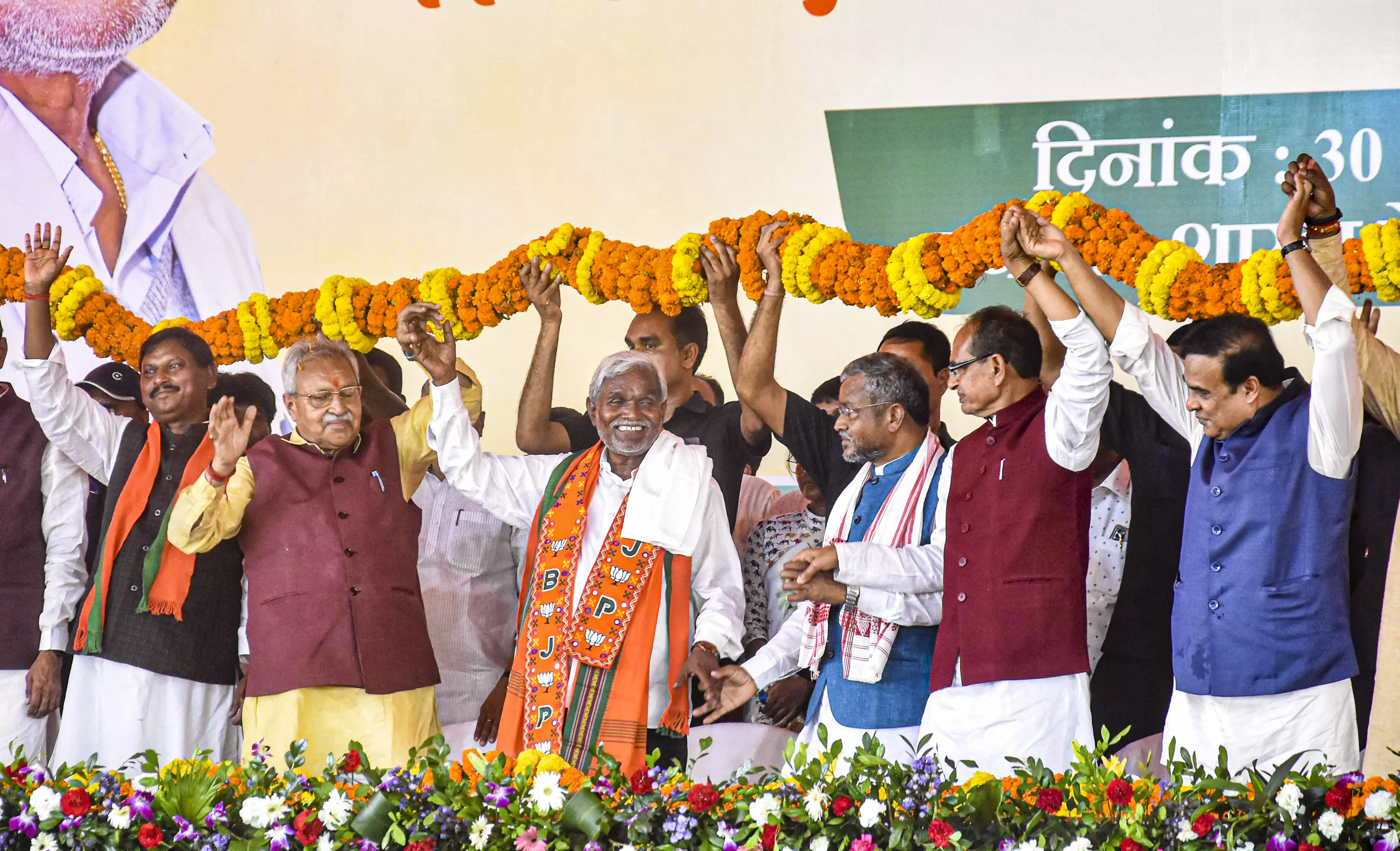
Jharkhand | Why BJP is eyeing Kolhan region ahead of Assembly elections
Top BJP leaders Babulal Marandi, Arjun Munda, Champai Soren and Madhu Koda are camping in the region that has 14 Assembly seats but the party drew blank in 2019 polls

With Prime Minister Narendra Modi sounding the poll bugle in Jharkhand on Sunday (September 15), the BJP has set its eyes on tribal-dominated Kolhan region.
The party’s resolve to register electoral gains in this region became amply clear when the prime minister headed for the rally venue in Jamshedpur via road from Ranchi airport after his chopper could not take off due to inclement weather conditions.
Kolhan region comprises of East Singhbhum, West Singhbhum and Seraikela Kharsawan districts, which is a focus area for the saffron party with 14 assembly seats, including nine tribal-majority constituencies. The BJP could not win any of the region’s 9 tribal segments during the 2019 Assembly elections. Out of the total 14 seats in the region, 11 seats were won by the JMM, two by the Congress, and one seat by an Independent. Interestingly, former Jharkhand Chief Minister Champai Soren, who recently joined the BJP, also hails from the region and holds considerable clout there.
Such is the BJP’s focus on Kolhan that former chief ministers Babulal Marandi, Arjun Munda, Champai Soren, Madhu Koda, and organisation secretaries Nagendra Nath Tripathy and Karmveer Singh are camping across the region.
‘Tiger of Kolhan’
A veteran of the Jharkhand statehood movement and a close aide of JMM patriarch Shibu Soren, Champai is often referred to as the “Tiger of Kolhan” by his supporters.
His crossover to the BJP evoked mixed response in the state’s political circles, with some leaders believing that it would hurt the JMM as he has been its only mass leader in the entire Kolhan division, which comprises three districts involving 14 Assembly seats.
A JMM MLA also said that Champai’s popularity in the Kollhan belt could not be underestimated. He opined that Champai had been nurturing Kolhan for the JMM for the last 30-35 years. He also has a strong connect with the people across all 14 Assembly seats and his emotional speeches strike a chord with local tribals. Underlining the party’s predicament, he said, “JMM needs to tread with caution while speaking against him, as we can't paint him as a villain.”
However, a close aide of Chief Minister Hemant Soren claimed that Champai wanted a ticket for his son in the Assembly polls, a demand which may well have been shot down by the JMM. “He is not a mass leader and mobilising support would have been tough for him. This could be one of the reasons why he joined the BJP as the organisational backing and the funds would make it easy for him,” he said, adding that Champai stands exposed today with his decision to join the BJP, the party he flayed until recently.
Pushing BJP’s agenda
Now that Champai Soren has joined the BJP, it will be interesting to see how he pushes the agenda of the saffron party, which he along with Shibu Soren fought against all these years.
Champai has already given a glimpse of it, saying that he wanted to save the tribal identity which is at stake in Santhal Pargana due to “rampant infiltration from Bangladesh”.
In an August 27 post on X, Champai alleged that the Bangladeshi infiltration has become a big problem in Santhal Pargana and that the “infiltrators” were allegedly occupying lands of the tribal communities. He also claimed that only the BJP seemed to be “serious” on this issue and that other parties were allegedly ignoring it for the sake of votes.
He said: “If these intruders, who are causing economic and social harm to the tribes and natives, are not stopped, the existence of our society in Santhal Pargana will be in danger. In many areas including Pakur, Rajmahal, their number has become more than that of tribals. Apart from politics, we have to make this issue a social movement, only then the existence of tribals will be saved.”
Sources said that with Champai backing this narrative the BJP would aim to win at least 10 ST (Scheduled Tribes)-reserved seats out of total 28 ST seats in the state in the elections to the 81-member Assembly slated for later this year.
JMM equally aggressive
On the other hand, the ruling Jharkhand Mukti Morcha (JMM) is not sitting quietly, as its working president and Chief Minister Hemant Soren is leading the INDIA bloc in this region that gave 13 seats (JMM 11, Congress 2) to the ruling coalition five years ago.
The remaining one seat (East Jamshedpur) went to Independent candidate Saryu Rai, who defeated the then Chief Minister Raghubar Das by a margin of 15,833 votes.
Soren has visited Kolhan four times in 20 days and is continuously holding meetings with JMM MLAs and workers. During this period, the chief minister twice attended major government programmes related to women beneficiaries in Champai’s home district of Seraikela.
The presence of the MLAs, MPs and ministers of INDIA bloc at such programmes is being seen as part of Soren’s strategy. In his speeches, he has been going all out against the BJP and the central government.
A major reason for Kolhan drawing so much attention from both the ruling as well as the Opposition party is the fact that the BJP feels that it can regain lost ground by focusing on the region after Babulal Marandi’s failure to establish clout in Santhal Pargana. CM Soren too is aware of the fact that the loss of even a few seats in the politically crucial region may land him in trouble.
Jharkhand is all set for the Assembly polls in November-December. Of the total 81 seats, 14 —9 reserved for tribals, one for scheduled castes, and four non-reserved — are in Kolhan region.

